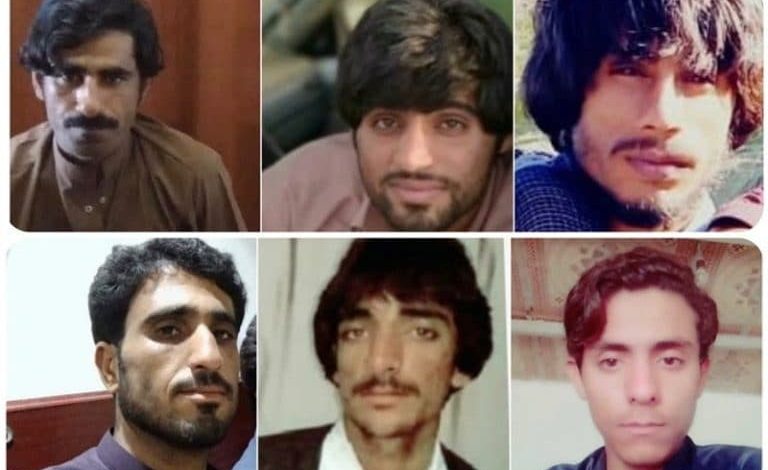IRGC Controls Iran’s Vast Network of Smuggling, Yet It Killed and Wounded Dozens of Fuel Carriers on Monday

Written by
Shamsi Saadati
Pictures of a number of Baloch citizens who were killed during today’s shooting by the IRGC forces in Sistan and Baluchestan Province, south west Iran
Pictures of a number of Baloch citizens who were killed during today’s shooting by the IRGC forces in Sistan and Baluchestan Province, south west Iran
On Monday, Revolutionary Guards (IRGC) forces opened fire on a group of fuel porters or “Sokhtbar” in the southeast Iranian province of Sistan and Baluchistan. Dozens of Sokhtbars were killed and wounded. While the IRGC controls Iran’s economy and organized smuggling network, it kills deprived porters.
IRGC forces dug large holes near the Iran-Pakistan borders preventing fuel porters’ movement. When deprived locals protested, the IRGC forces opened fire on protesters, killing at least eight people and injuring dozens. IRGC forces have dumped the bodies of several victims into a canal and have not allowed anyone to approach the bodies.
Sistan and Baluchistan is one of the poorest provinces in Iran. Baluchi ethnic minorities are under the double pressure of poverty and the regime’s oppressive measures. To make ends meet and feed their families, deprived Baluchi citizens have to carry a few gallons of fuel to eastern Pakistan.
The IRGC forces take the lion’s share of what fuel porters earn, and when they refuse to pay them, the IRGC forces open fire on them. In addition, the fuel carriers have to endure dangers of the road, extreme hot weather, or having fatal road accidents.
February 22 – #Iran/Pakistan border
IRGC units opened fire on dozens of Baluch locals who carry fuel over the border. Eight reportedly dead and dozens wounded.
A village near an IRGC base has been attacked, forcing residents to flee.pic.twitter.com/LPjhZj2kdZ— People's Mojahedin Organization of Iran (PMOI/MEK) (@Mojahedineng) February 22, 2021
Some of the regime’s officials have acknowledged the poor living conditions in Sistan and Baluchistan.
“We traveled to the city of Iranshahr, the second-largest city in southeast Iran, and visited its villages. Unfortunately, the people of this area are deprived of facilities, such as showers and toilets. There were no suitable electricity facilities in the villages,” MP Ali Khezrian admitted on September 5, 2020.
Yet, the IRGC forces systematically kill Baluchi “Sokhtbars” as a part of their oppressive measures to intimidate the public.
On February 17, the IRGC and border security forces opened fired and killed a 19-year-old Baluchi Sokhtbar, identified as Mohammad Snjarzehi. Mohammad’s father was also shot and killed by the regime’s forces.
Similar to Sokhbars in southeast Iran, border porters, or Kolbars are being systematically killed by the regime’s border forces and IRGC in northwest Iran.
In the most recent case, on February 8, the regime’s forces shot and killed 37-year-old Iranian Kurdish citizen Behzad Hashemi in northwest Iran. Behzad was married and had three children.
The regime’s forces on the western border shot and killed another border porter on February 3. The victim was identified as Khaled Ahmadpour. He was married and had two children.
Since border provinces in Iran have the highest rate of unemployment, many locals turn to porting goods or becoming kolbars. The regime’s inappropriate division of wealth in these provinces, its lack of attention to the provinces’ economic potential, and the mullahs’ ineffective management are among factor which prompt deprived locals to become porters.
The truth:
The IRGC kills deprived Kolbars and Sokhtbars, claiming it is fighting smuggling. But, in fact, Iran’s largest mafia and smuggling network is under the IRGC’s control. According to reports obtained by the Iranian Resistance, the IRGC controls the majority of this smuggling network and controls nearly 90 ports in Iran, which are nearly 45% of Iran’s 212 official ports. The IRGC’s imports and exports from these ports is evaluated at nearly $12 billion each year.
Border porters are workers who carry heavy loads across the border for a meager pay. Due to the lack of economic development, increasing poverty and unemployment in western #Iran, more and more #Iranian Kurds are forced to take up this dangerous and harsh occupation. pic.twitter.com/zxQbtPOZTY
— IRAN HRM (@IranHrm) February 22, 2021
In this regard, the state-run Tasnim news agency on May 5, 2017 wrote: “The figure of $15-20 billion of smuggled goods is not a low figure for our country; it is natural that the entrance of goods from illegal channels can deliver irrecoverable damages. From an economic point of view, the uncontrolled entrance of smuggled goods will lead to the end of the country’s domestic production, and this could have meant jobs for two million people.”
In 2017, the Iranian Resistance published a report about the IRGC’s smuggling network. “State-linked institutions, including the Revolutionary Guards (IRGC), have taken control over Iran’s ports and are meddling in customs affairs, literally transforming these economic centers to transits used to smuggled goods. The IRGC, by taking control over the country’s most important economic routes and establishing a major financial empire, has taken full control over large portions of Iran’s imports/export,” read the report in part.
As Mrs. Maryam Rajavi, the Resistance’s President-elect, had said: “The clerical regime plunders the wealth of the people of Iran or wastes it on war and suppression. Children of the regime’s leaders are living lavish lives in Europe and the U.S. while deprived Iranian children have to work as porters.”
As the Iranian Resistance has repeatedly said, the only way to end these atrocities is the clerical regime’s overthrow, which is the Iranian people’s desire.
The freezing to death of a 14-year-old porter in the mountains of #Iran shocks every human being. Instead of going to school, Farhad had to carry heavy loads and work as a porter to earn a living.
— Maryam Rajavi (@Maryam_Rajavi) December 21, 2019

